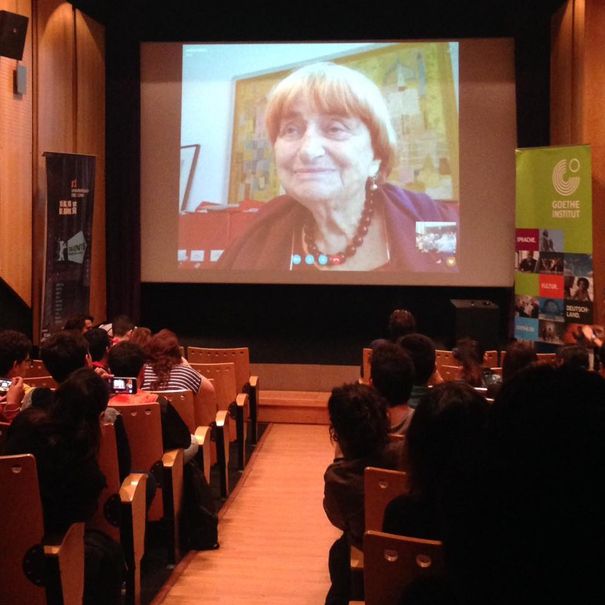Chronicle of the session Sans Toit ni Loi with Agnès Varda
By Iván Zgaib | Argentina

Agnes Varda at Talents Buenos Aires 2016
“Imagine you had to make Sans Toi ni Loi today. What kind of film do you think it would be?”, asks Roger Koza, programmer, critic and moderator of this session. In front of him, Varda’s face is projected on a giant screen at Universidad del Cine’s theatre in San Telmo. It is Saturday afternoon and, from their seats, the participants watch the blown-up image of the French director who, via Skype, initiates the possible reflections based on the central theme of this edition of the Talents Buenos Aires: “No Limits, Nor Law”.
Roger Koza’s opening question makes reference to the film Varda shot in 1985, which he brings to a contemporary context in order to discuss today’s cinema. Sans Toi ni Loi is, in that sense, a film that surpasses the boundaries of time and that, even today, can update the discussions about the narrative and aesthetic possibilities cinema has to approach the world and to reflect upon itself.
It is perhaps because of this that this new edition of Talents Buenos Aires (“No Limits, Nor Law”) borrows the title of the film, so as to reestablish a reflection on today’s independent cinema. Varda and her work give rise to multiple questions: What escape routes can new directors open in a context that is ruled by the industry’s standards? How to arouse freedom and rebellion towards a younger, more innovative cinema?
Within this context, Sans Toi ni Loi presents formal as well as narrative connections, from the most literal aspect: the protagonist is a young woman who spends her days without tying herself to any fixed spaces or particular limits, moving away from society to avoid the rules that might restrict her life. During the session, Varda makes reference to the first images that aroused her interest in the story for this film, describing the persons she began to encounter in the routes of France at the beginning of 1980. “I did a lot of research back then. I picked up men and women that were living on the street and asked them how they did it, why they lived liked that. And most of them were against society”, says the French director.
Periphery is, in this way, a central aspect in the work of Agnès Varda and of Sans Toi ni Loi in particular, given that here the social relations are weaved through the distance between the protagonist and the rest of the characters. “The weaknesses that people highlight about Mona (the protagonist, played by Sandrinne Bonnaire) do not describe her as much as they describe the society that rejects her”, states Varda. “It is a film about society or about a part of the country that rejects foreigners, people who are different like Mona, persons who live on the street”, she adds.
The peripheral experience that the director portrayed thirty years ago is still a reality which today has acquired new meanings: “We have thousands of immigrants who arrive in Europe (…) not for the desire to be free or to live on the street. They want to flee their countries to earn money, but are now trapped in a horrible situation”, Varda declares.
Besides addressing the narrative conflict of the film, Koza makes a point in the director’s formal decisions to approach Mona and the characters that surround her. In Sans Toi ni Loi, there are travellings and characters who look and talk directly to the camera, breaking the idea of representation and of narrative fiction. For Varda, this decision considers characters as “witnesses”, a similar role that the audience adopts when observing Mona’s journey while she tries to survive on the road. “In a way”, says the creator of Les plages d’Agnès “you could be asked at the end of this film: what do you think about this woman?”.
The conversation comes to an end and Varda expresses her gratitude for learning that there are still people who, three decades later, want to see her film. This brings us back to the present, to this theatre packed with new directors, and demonstrates the value that the work of this director still has as regards cinema and its history. “Mona’s rage”, Koza says, “speaks about a time in history and a way of looking at certain problems. And today, a long time later, sheds light on the cinema of the present”.
Roger Koza - Moderator, programmer and Film Critic Mariángela Martínez Restrepo - Talent Press BsAs Coordinator Clara Picasso -Text translator

